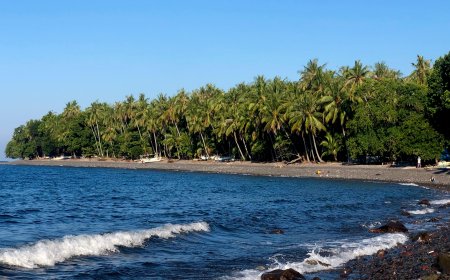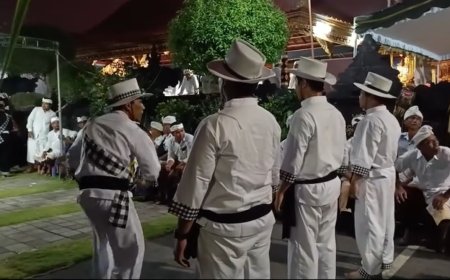I Gusti Agung Maruti's Rebellion: the Tampaksiring and Pejeng dispute, involving the King of Gianyar
Tampaksiring is a district rich in tourist destinations, temples and other beautiful places. In addition to having many tourist attractions, in Tampaksiring sub-district there is also a village that becomes a barrier between Tampaksiring sub-district and Pejeng sub-district, called Sanding village.

Sanding Village is a village located in the middle of Tampaksiring and Pejeng sub-districts, as well as being the border between the two sub-districts. The village has existed since the megalithic era with the discovery of a sarcophagus in Banjar Padangsigi, ancient Balinese writing on the yoni stored in Pura Puseh Desa Sanding which reads the year 1312 caka, and also based on the existence of statues stored in Pura Masceti which are thought to date from the middle Balinese period.
During the reign of Dalem Ketut Ngulesir in Gelgel, a figure named Bujangga Anglayang fled to Sanding. In Sanding, Bujangga Anglayang married and had a son named Bang Sanding who would succeed his father as dukuh of Sanding. Bang Sanding had four sons, namely Sang Sanding, Dukuh Mayasan, Dukuh Mawang, and Dukuh Dadapan. Sanding Village was attacked by the Gelgel Kingdom led by Arya Kepakisan, Pasek Gelgel, Arya Kebon Tubuh, Arya Penatih. To avoid the attack, the entire population of Sanding Village was evacuated to various areas. The village became deserted, with only members of the King of Gelgel's army keeping watch.
In 1638 there was an attempted seizure of power by I Gusti Agung Maruti (patih) by intercepting the procession of Dalem Dimade (King of Gelgel) who was going to Besakih Temple to pray. The King's troops were unable to fight back because I Gusti Agung Maruti's troops were very numerous. King Gelgel was captured and hidden in Galiran Village. Upon hearing that King Gelgel was being held by I Gusti Agung Maruti, the Tabanan Kingdom led by Ki Tabanan agreed to free King Gelgel.
Persimpangan Temple Sanding Village (Photo Source: Editorial Collection)
I Gusti Agung Maruti, who knew that he would be attacked, felt unable to fight and could not continue his ideals. I Gusti Agung Maruti then went to the King to beg for forgiveness for his actions and asked the King to say nothing happened. I Gusti Agung Maruti's request was granted by the King of Gelgel to avoid bloodshed. I Gusti Agung Maruti returned to his position as patih in the Gelgel Kingdom.
The good attitude of the King of Gelgel made the officials feel disappointed with the King for overreacting to I Gusti Agung Maruti. In addition, the disappointment of the officials was also caused by the King's policy of giving the Ki Lobar Heritage Kris to his son-in-law named Den Bencingah. Seeing the weak leadership of Dalem Dimade, I Gusti Agung Maruti exceeded the King's authority and rebelled.
In 1651, a rebellion broke out in the Gelgel Kingdom under the leadership of I Gusti Agung Maruti. Swecapura Palace was locked up tightly and every door was heavily guarded. In the war, Dalem Dimade suffered defeat. Dalem Dimade and his two sons I Dewa Pemayun and I Dewa Jambe escaped to Guliang. Dalem Dimade died in Guliang, and after a long time living in Guliang, I Dewa Pemayun and I Dewa Jambe separated. I Dewa Jambe went to Sidemen Karangasem, and I Dewa Pemayun went to Tampaksiring Hill. I Dewa Pemayun had three sons, namely I Dewa Pemayun Putra (moved to Pejeng), I Dewa Pemayun Made (moved to Blahbatuh), and I Dewa Pemayun Anom (moved to Tampaksiring).
In Tampaksiring I Dewa Pemayun Anom extended his authority to the south of Bukit (the former village left by the previous dukuhs) and Kulub. This expansion of power resulted in a dispute with his brother I Dewa Pemayun Putra who ruled Pejeng. Unable to fight his own brother, I Dewa Pemayun Anom sought protection from the King of Gianyar to settle the dispute. The King of Gianyar, I Dewa Manggis Api, sent his son and nephew to build a fort in the border area between the two regions of Tampaksiring and Pejeng, namely Sanding. The boundary of the fort was from the Sanding Mancawarna Junction Temple to the south before the Blusung Village Temple.
Blusung Village Temple (Photo Source: Editorial Collection)
I Dewa Pemayun Anom was guarded by four pacek and their retinue. Three pacek came from the Bitra area and were placed in the eastern fort which was named Sanding Bitra. The pacek to the west of Sanding Bitra (center) came from the Seronggo village of Gianyar, the place was named Sanding Serongga, the westernmost pacek came from the Abianbase village of Gianyar and was named Sanding Abianbase. Troops from the Kingdom of Gianyar departed for Sanding in 1854. After the dispute between Tampaksiring and Pejeng was resolved, the King of Gianyar sent a pacek on behalf of Puri Gianyar which was placed in Sanding Gianyar.





























































